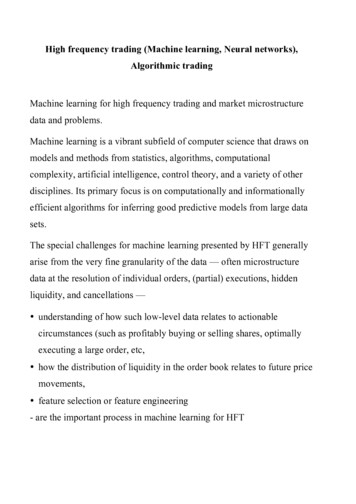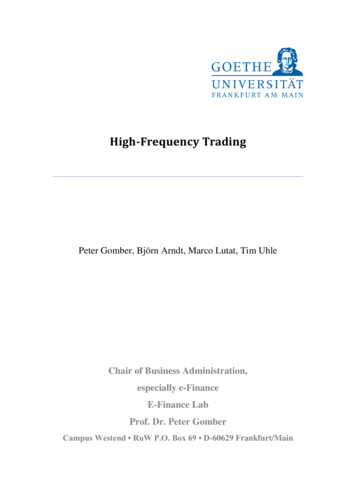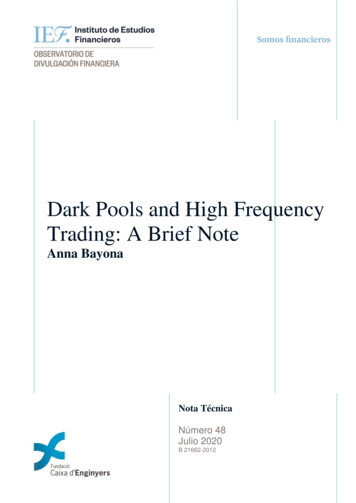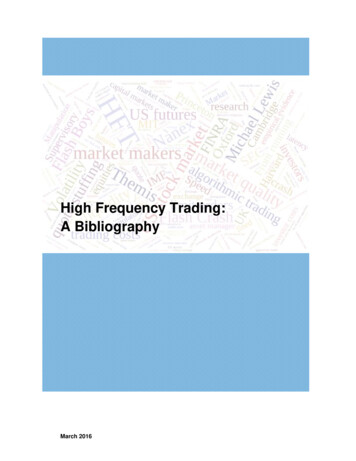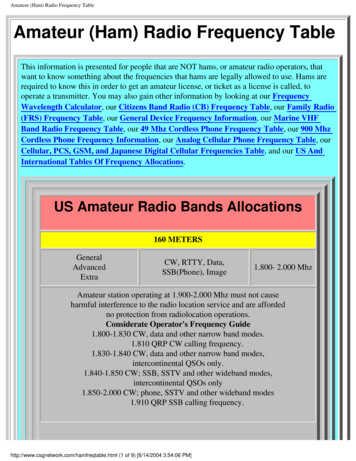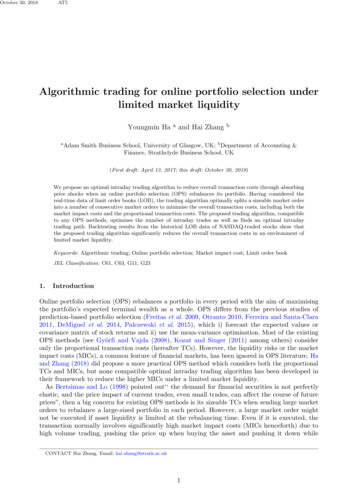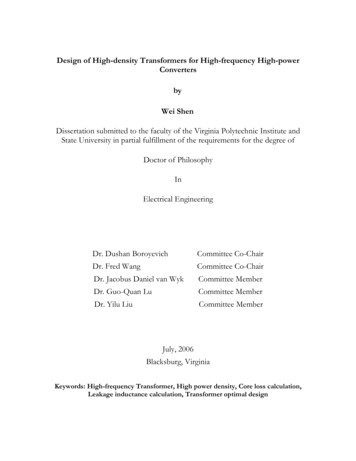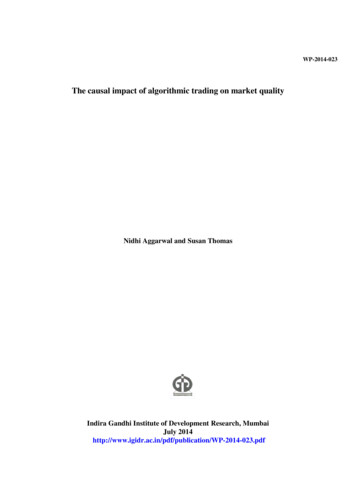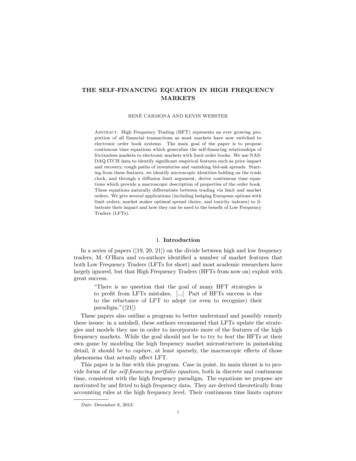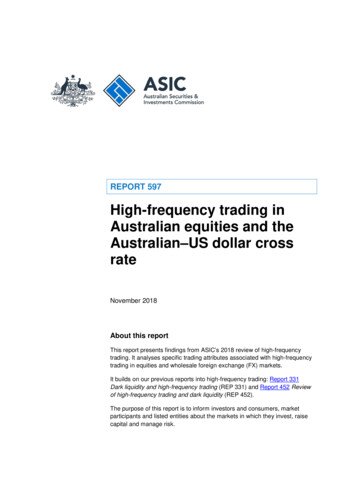
Transcription
REPORT 597High-frequency trading inAustralian equities and theAustralian–US dollar crossrateNovember 2018About this reportThis report presents findings from ASIC’s 2018 review of high-frequencytrading. It analyses specific trading attributes associated with high-frequencytrading in equities and wholesale foreign exchange (FX) markets.It builds on our previous reports into high-frequency trading: Report 331Dark liquidity and high-frequency trading (REP 331) and Report 452 Reviewof high-frequency trading and dark liquidity (REP 452).The purpose of this report is to inform investors and consumers, marketparticipants and listed entities about the markets in which they invest, raisecapital and manage risk.
REPORT 597: High-frequency trading in Australian equities and the Australian–US dollar cross rateAbout ASIC regulatory documentsIn administering legislation ASIC issues the following types of regulatorydocuments.Consultation papers: seek feedback from stakeholders on matters ASICis considering, such as proposed relief or proposed regulatory guidance.Regulatory guides: give guidance to regulated entities by: explaining when and how ASIC will exercise specific powers underlegislation (primarily the Corporations Act) explaining how ASIC interprets the law describing the principles underlying ASIC’s approach giving practical guidance (e.g. describing the steps of a process suchas applying for a licence or giving practical examples of howregulated entities may decide to meet their obligations).Information sheets: provide concise guidance on a specific process orcompliance issue or an overview of detailed guidance.Reports: describe ASIC compliance or relief activity or the results of aresearch project.DisclaimerThis report does not constitute legal advice. We encourage you to seek yourown professional advice to find out how the Corporations Act and otherapplicable laws apply to you, as it is your responsibility to determine yourobligations.Examples in this report are purely for illustration; they are not exhaustive andare not intended to impose or imply particular rules or requirements. Australian Securities and Investments Commission November 2018Page 2
REPORT 597: High-frequency trading in Australian equities and the Australian–US dollar cross rateContentsExecutive summary . 4High-frequency trading review—Key findings. 4Australian equity markets . 5AUD/USD cross rate . 5Key statistics . 6Next steps . 6AHigh-frequency trading . 7Purpose. 7Background . 8Our definition of high-frequency trading . 9How we identified high-frequency trading . 9BAustralian equity markets . 12Purpose. 12Background . 13B1 High-frequency trading in Australian equity markets . 13Our approach . 13High-frequency traders. 14Market turnover . 14Market concentration. 16Percentage of book traded . 17Inventory holding time . 18Number of ‘fast messages’ . 21Behaviour of high-frequency traders’ order books . 22Order-to-trade ratios . 24Aggressive trading . 26Cost to investors . 28B2 Impact of high-frequency trading on price discovery . 30Are market prices becoming more efficient?. 30Are high-frequency traders contributing to price discovery?. 32B3 Summary of key findings . 33CAustralian–US dollar cross rate . 35Purpose. 35Background . 35C1 High-frequency trading in AUD/USD cross rate . 40Our approach . 40High-frequency traders. 42Market turnover . 44Orders submitted to market . 46Percentage of book traded . 47Inventory holding time . 48Number of ‘fast messages’ . 49Basis points earned. 50Order-to-trade ratios . 51Facilitation by high-frequency traders . 52C2 Issues with high-frequency trading in AUD/USD . 53Intra-platform arbitrages . 54Transaction costs in the AUD/USD cross rate . 56C3 Summary of key findings . 64Key terms . 65Related information . 69 Australian Securities and Investments Commission November 2018Page 3
REPORT 597: High-frequency trading in Australian equities and the Australian–US dollar cross rateExecutive summary1Speculative trading on electronic markets is dominated by small groups oftraders. These individuals and organisations rely on sophisticated andquantitative models to predict short-term price movements. They tradethrough automated systems that are programmed to assess opportunities,execute orders and manage risk—all conducted with minimal manualintervention. These are the high-frequency traders that have evolved todominate our trading landscape.2While their toolsets have become widely adopted by other professionals,their speed of execution and tight management of risk set them apart fromother classes of investors and market users. Their enormous contribution tomarket activity has made them a focus for regulators.3Our study throws light on many of the unobservable practices of highfrequency traders. Using privileged data, we analyse key characteristics ofhigh-frequency trading and place them in the context of wider marketpractices. We look at measures of market quality affecting the wider marketand determine how they are impacted by high-frequency trading.4High-frequency trading remains a topical market structure issue. In 2012 and2015, ASIC taskforces assessed the impact of high-frequency trading on thequality and integrity of our equity and futures markets. These reviewsculminated in:5(a)Report 331 Dark liquidity and high-frequency trading (REP 331) andConsultation Paper 202 Dark liquidity and high-frequency trading:Proposals (CP 202); and(b)Report 452: Review of high-frequency trading and dark liquidity(REP 452).Over 2018, we undertook a further review of high-frequency trading acrossthe Australian equity and wholesale Australian–US dollar (AUD/USD) crossrate markets. This review builds on our earlier analysis of Australian equitymarkets and extends our oversight into the global FX markets.High-frequency trading review—Key findings6Automated trading dominates the Australian equity markets and FXelectronic platforms. Natural investors, risk managers and professionalfacilitators have embraced the use of algorithms within their executingbusinesses. Australian Securities and Investments Commission November 2018Page 4
REPORT 597: High-frequency trading in Australian equities and the Australian–US dollar cross rate7High-frequency trading is a form of automated trading but is solely directedat extracting short-term, low-risk profits. The tactical advantages enjoyed byhigh-frequency traders have dissipated as algorithmic execution has growninto a mainstream tool—their industry’s growth has tapered off.Australian equity markets8High-frequency traders retain a large presence within the Australian equitymarket but their contribution to turnover has weakened. In a growing market,turnover has fallen from 27% to 25%: see paragraphs 46–52.9The largest high-frequency traders continue to dominate turnover. Crosssectional participation declined sharply across the cohort: see paragraphs 53–55.10These traders are investing in faster technologies and reacting to similarsignals. Speed of execution gives them a competitive edge, but it is not theironly measure of success. High-frequency traders are broadening their tradingstrategies and increasingly taking on more market risk: see paragraphs 56–74.11High-frequency traders contribute disproportionately to price discovery, butthis utility declines as market volatility falls: see paragraphs 116–120.AUD/USD cross rate12High-frequency traders have a significant presence across global electronicplatforms. The market share of high-frequency traders peaked at 35% inMay 2013 but has since fallen. They are currently responsible for 25% ofmulti-dealer platform turnover: see paragraphs 152–161.13The number of distinctly different high-frequency traders captured withinour dataset continues to decline, but their relative concentration hasincreased. Volumes within the multi-dealer platforms are falling, and thetraditionally dominant venues are losing market share to newer andunlicensed competitors. High-frequency traders are now able to interact withmore investors within trading venues with lower regulatory oversight: seeparagraphs 140–151.14High-frequency traders are adopting riskier strategies. Holding times areincreasing and churn rates are falling. Lower liquidity has constrainedopportunities; relative performance is better but falling volumes havecurtailed industry profitability: see paragraphs 168–183.15High-frequency traders are facilitating dealers. They are supplying liquiditydisproportionately into higher cost demand. Adverse selection costs borneand managed by high-frequency traders are exacerbated by dealers chasingvolume: see paragraphs 224–229. Australian Securities and Investments Commission November 2018Page 5
REPORT 597: High-frequency trading in Australian equities and the Australian–US dollar cross rateKey statistics16Some of the key statistics from our analyses are summarised in Table 1. Itshows the relative contribution of high-frequency traders in the Australianequity and AUD/USD cross rate markets. While representing a small portionof market users, high-frequency traders are responsible for adisproportionately large amount of activity.Table 1:Key summary statistics on high-frequency tradingMeasureEquitiesAUD/USD cross rate 0.5%2%Turnover25%25%Number of trades27%31%Number of orders45%38%Trading accountsNext steps17We will continue to publish equity market data on our website.18We will also continue to monitor Australian equity markets and will becommencing a series of onsite visits to organisations involved in FX tradingfor Australian clients.19Changes to the cost recovery regime are impacting the business models ofalternative market platforms operating within the Australian jurisdiction. Weare progressively engaging with platform providers and will be reaching outto organisations offering institutional trading in foreign exchange towholesale Australian clients.20Feedback on the issues raised in this report is welcome and may be sent tohft.report@asic.gov.au.Note: To ensure confidentiality please mark any correspondence as ‘in confidence’. Australian Securities and Investments Commission November 2018Page 6
REPORT 597: High-frequency trading in Australian equities and the Australian–US dollar cross rateAHigh-frequency tradingKey pointsThe scope of our analysis is high-frequency trading within the Australianequity and the AUD/USD FX markets. We seek to inform investors on highfrequency trading and provide transparency on the nature of its interactionwith their investments.The International Organization of Securities Commissions (IOSCO) hasdefined high-frequency trading as a form of automated proprietary tradingusing high-speed algorithmic technology to pursue short-term, low-riskprofits. Many professional investors also use automated tools to pursueinvestment mandates.We constructed an objective index to identify high-frequency traders acrossthe equity and AUD/USD cross rate markets. Inferences on participation,behaviour and impact were drawn out over the span of our surveillancedata.Our approach to identifying high-frequency traders was based on IOSCO’sdefining principles. We did not prejudge individuals, entities ororganisations. We found that a number of large proprietary tradingorganisations active within the Australian equity and AUD/USD cross ratemarkets were regularly captured by our methodology.Purpose21Financial markets are a key component of infrastructure supportingAustralian economic development. They facilitate and inform the flow ofcapital between investors and businesses, and provide tools for hedging andmanaging many types of economic risks. Their size and complexity havegenerated an ecosystem of financial intermediaries seeking to extractmarginal value from this natural flow of funds.22High-frequency trading is an example of financial intermediation developedto exploit modern electronic markets. High-frequency traders do not investand have no ongoing interest in the businesses or products of theirtransactions. They exploit technological advantages in pricing and executionto trade inefficiencies within an imperfect market. Their scale of activity,depth of presence and potential to affect price formation make them a pointof interest to all custodians of market efficiency, fairness and integrity.23Concern with high-frequency trading peaked in 2014 following the releaseof Michael Lewis’ Flash Boys: A Wall Street Revolt. This book popularisedthe notion of a systemic fault in market microstructure allowing traders to Australian Securities and Investments Commission November 2018Page 7
REPORT 597: High-frequency trading in Australian equities and the Australian–US dollar cross ratefront-run investor orders using high-speed computerised trading systems.Our 2015 report found no evidence of this behaviour within our equity orfutures markets, and industry’s immediate concerns with this form of tradinghave abated.24In this study we update our estimates of high-frequency activity within theAustralian equity market and provide an additional measure of impact onmarket quality by high-frequency trading. We also extend our study into theglobal AUD/USD FX market. We analyse trading by global marketparticipants and traders—many of whom operate outside our immediategeographical jurisdiction—and comment on their presence in, and effect on,Australia’s dominant FX market.25This section outlines how we defined and identified high-frequency tradingwithin our markets. In particular, we discuss:(a)our approach to defining a behaviour that constitutes high-frequencytrading (see paragraphs 29–31); and(b)how we profiled our surveillance data to identify high-frequency traders(see paragraphs 32–38).Background26High-frequency trading remains an area of interest to ASIC. Our marketsurveillance system continues to monitor the Australian equity, equityderivatives and futures markets for suspicious and disorderly activity.27In REP 452, we discussed our concerns about a practice of excessive tradingby some traders in the ASX 24 futures roll market—a practice we consideredwas problematic to other users of that market. In 2017, we issued aninfringement notice against a proprietary trading organisation in relation toits trading within the 10-year Commonwealth Treasury Bond roll. TheMarkets Disciplinary Panel alleged breaches of Rule 3.1.2 of the ASICMarket Integrity Rules (ASX 24 Market) 2010.Note: See Media Release (17-461MR) Epoch Capital Pty Ltd pays 130,000 ininfringement notice penalty.28We also investigated AUD/USD cross rate markets in the context of theReserve Bank of Australia (RBA) cash rate announcements followingconcerns that early 2015 rate decisions may have been leaked. We found noevidence of informed trading. However, we did conclude that some highfrequency traders ran potentially dysfunctional algorithms. We notedsimplistic scalping strategies that were ill-suited to markets of low liquidity.Much of the price volatility observed before rate announcements was drivenby cascading high-frequency scalpers off-loading small but poorly timed riskinventory. Australian Securities and Investments Commission November 2018Page 8
REPORT 597: High-frequency trading in Australian equities and the Australian–US dollar cross rateOur definition of high-frequency trading29High-frequency trading has been described in various ways. Consistent withour previous approach, we relied on an IOSCO definition which identifiedhigh-frequency trading as:(a)the use of sophisticated technological tools to pursue a range ofstrategies, such as market making and arbitrage;(b)a highly quantitative tool that employs algorithms to analyse marketdata, deploy profit-seeking strategies, and minimise trading costs andexecution instructions;(c)characterised by a high daily turnover and high order-to-trade ratios(i.e. large numbers of orders are cancelled in comparison to tradesexecuted);(d)involving flat or near flat positions at the end of the trading day,meaning that little or no risk is carried overnight, with obvious savingson the cost of capital associated with margined positions;(e)mostly employed by proprietary trading firms or desks; and(f)latency sensitive. The implementation and execution of successful highfrequency trading strategies depend primarily on the ability to be fasterthan competitors and to take advantage of services such as directelectronic access and co-location.Note: Technical Committee of IOSCO, Regulatory issues raised by the impact oftechnological changes on market integrity and efficiency (PDF 587 KB), consultationreport, July 2011.30Many of these characteristics have been adopted by other participants acrossthe market. Automation is now the norm among the market’s largerparticipants where economies of scale and modern trends have tiltedbusinesses towards the adoption of algorithms.31Our analysis consistently identified a small cohort of entities withbehaviours that matched the characteristics of high-frequency tradingdescribed by IOSCO. These entities represented a small percentage ofmarket users but projected an enormous presence into the market. We referto these entities as ‘high-frequency traders’.How we identified high-frequency trading32To identify high-frequency trading we scored individual traders daily acrosssix measures motivated by IOSCO’s characteristics (see paragraph 29) ofhigh-frequency trading. Australian Securities and Investments Commission November 2018Page 9
REPORT 597: High-frequency trading in Australian equities and the Australian–US dollar cross rate33Table 2 outlines the rationale for selecting each measure, and the specificmetrics used.Table 2: The measures used to identify high-frequency tradingMeasureMetric usedRationale for measureOrder-to-traderatioThe number of orderssubmitted to market (neworders, amendments anddeletions) divided by thenumber of trades executedHigh-frequency trading typically involves placing manyorders for short periods over various price levels. Highorder-to-trade ratios suggest automation, agility and lowerrisk tolerance. High-frequency traders, especially thosethat supply liquidity, tend to have a high order-to-traderatioInventory tradedwithin a dayOne minus the overnightresidual value held divided bytotal turnover in each security.Values are weighted byrelative turnover in eachsecurityThis metric captures the extent to which intradaypositions are liquidated before day’s end. High-frequencytraders tend to close out a large proportion of theirtrading. Their overnight positions are relatively small. Thismetric distinguishes high-frequency traders fromexecution algorithms which trade in one direction over adayFor foreign exchange, this measure was tightened toreflect trading over hourly intervalsTotal turnoverper dayGross purchases and salesHigh-frequency trading is a low-margin strategy. Tradersare highly active in the market to ensure profitability.High-frequency traders have high turnoverTurnover is measured in units of Australian dollars forboth equity and foreign exchangeNumber of fastmessagesAbsolute number of messagessuccessfully submitted within ashort period after a definedeventHigh-frequency trading is fast—traders will demonstrate acapacity to respond to events over short periodsThe period was set to 40 milliseconds for equities and200 milliseconds for foreign exchangeHigh-frequency traders manage their orders in differentways. Some delete and send new orders, others submit arolling sequence of amendmentsHolding timeThe average time that aposition is held weighted bydollar valueHigh-frequency trading typically involves trading in andout of positions many times in a day. Frequent, shallowand changing positions are core to this trading style.High-frequency traders tend to have low holding timesSophisticationGross revenue divided by totalturnoverHigh-frequency traders run strategies that benefit fromhigh turnover and use systematic risk management.Sustainable and consistent profitability from highfrequency trading demonstrates sophistication34We set some hard barriers to screen candidate traders against a highfrequency classification. For equity traders we determined limits at aminimum 1,000 orders per day, a minimum of five different concurrent Australian Securities and Investments Commission November 2018Page 10
REPORT 597: High-frequency trading in Australian equities and the Australian–US dollar cross ratesecurities, a maximum three-hour holding period and a minimum turnover of 100,000 per day.35In foreign exchange, the minimum number of securities was removed andthe turnover barrier raised to 20 million.36Individual traders were scored and ranked across each metric. Each trader’sscore was then determined by adding together their six rankings. Traderswith an overall score equal to, or greater than, a threshold percentage of thetop score were identified as the day’s high-frequency traders. Respectivethresholds of 50% and 70% were used for equity and foreign exchange.37This process was repeated daily for all traders within our surveillance data.38Our method of identifying high-frequency traders was data driven. It wasobjective and derived from observed behaviour. We made nopredetermination on inclusion but some large omnibus-type accounts werespecifically excluded. While there was movement into and out of the highfrequency trader classification, a number of identified trading accounts, andentities that operated business models generally considered to be highfrequency trading, did tend to fall into this category on a consistent basis. Australian Securities and Investments Commission November 2018Page 11
REPORT 597: High-frequency trading in Australian equities and the Australian–US dollar cross rateBAustralian equity marketsKey pointsWe analysed trading in Australian equity markets over the period March2015 to March 2018 to assess recent levels of high-frequency trading andthe behaviour of high-frequency traders. We compared current findings withthose made in our 2015 review.The level of high-frequency trading in equity markets has fallen over thepast three years. A steady downtrend in participation rates has highfrequency trading accounting for 25% of all turnover. Participation hasfallen strongly across higher capitalisation securities. Concentration hasweakened slightly with the 10 largest high-frequency traders accounting for74% of all high-frequency trading turnover. Activity continues to increaseoutside of the top 200 securities.High-frequency traders are becoming faster but the technological armsrace is producing minimal gains. Profitability is stagnant, and the costimposed on other intermediated market users is falling.Order-to-trade ratios continue to fall but remain susceptible to pricesensitive events. Ratios can quickly revert with bursts in market volatility.Predictive algorithms are feeding into short-term price moves. Highfrequency traders are contributing disproportionately to short-term pricediscovery; however, the derived public benefit varies across bothcapitalisation and volatility. High-frequency traders are capturing economicliquidity rental in lower capitalised securities under conditions of lowvolatility.Purpose39This section outlines the findings of our high-frequency trading review intothe Australian equity markets.(a)Section B1 High-frequency trading in Australian equity marketssummarises the characteristics of high-frequency trading in theAustralian equity markets in the 300 highest capitalised securities: seeparagraphs 44–102.(b)Section B2 Impact of high-frequency trading on price discoverypresents our findings on the impact of high-frequency trading on themarket’s price discovery process: see paragraphs 108–120. Australian Securities and Investments Commission November 2018Page 12
REPORT 597: High-frequency trading in Australian equities and the Australian–US dollar cross rateBackground40REP 452 quantified the presence of high-frequency traders across theAustralian equity markets. In March 2015, they accounted for 27% of allmarket turnover and 45% of all orders submitted to market.Note: We have revised REP 452’s estimate of order share from 47% to 45%.Paragraph 43 explains a slight change in methodology afforded by ASIC’s regulatorydata feed introduced in March 2014.41REP 452 concluded that wider concerns with predatory behaviour could notbe attributed to high-frequency trading across our market. Whileacknowledging the speed and operational advantages of these traders, wedetermined that most occurrences of latency arbitrages evident in the markethistory were artefacts of clock drift between exchanges.42In REP 452, we also examined high-frequency trading’s effect oninstitutional transaction costs and found little evidence of systematic frontrunning, price gouging or volatility creation. We placed a relatively benignestimate on high-frequency facilitation costs, marking trader liquidity asreasonably priced within the context of wider competitor flow.43This report looks at recent trading with minor changes to methodology. Wenow use ASIC regulatory data field ‘origin of order id’ to aggregate activityinto individual traders. We also collate security quartiles by marketcapitalisation, rather than turnover. These changes are minor and createdminimal revisions to previous estimates in earlier reports.B1 High-frequency trading in Australian equity marketsOur approach44We analysed trading data across exchange markets and dark trading venuesin equity market products over the period 1 January 2015 to 31 March 2018.Our estimates of presence and impact were calculated daily. Ourobservations focused on trends and patterns of behaviour. Any commentaryon observations has been made against a three-month rolling average. Anycommentary on change has been made over a three-year period commencing31 March 2015 in line with the endpoint of our 2015 report.45Unless stated otherwise, our analysis was based on the top 300 securities foreach trading day. We ranked all securities in the equity markets each day bymarket capitalisation (the largest security by capitalisation was ranked 1) andseparated them into five bands:(a)Quartile 1: Securities ranking 1 to 50;(b)Quartile 2: Securities ranking 51 to 100;(c)Quartile 3: Securities ranking 101 to 150; Australian Securities and Investments Commission November 2018Page 13
REPORT 597: High-frequency trading in Australian equities and the Australian–US dollar cross rate(d)Quartile 4: Securities ranking 151 to 200; and(e)200–300: Securities ranking 201 to 300.High-frequency traders46The number of individual accounts identified as engaging in high-frequencytrading remained small. Over the three-year period of our study there wasminimal change in the number of high-frequency traders. A sharp increase inclassification did occur over August 2015 following the shock devaluation ofthe Chinese yuan. Market volatility preceded a decline in market levels toJanuary 2016 lows and led to a temporary increase in the number ofidentifi
High-frequency trading in Australian equities and the Australian–US dollar cross rate . November 2018 . About this report . This report presents findings from ASIC’s 2018 review of high-frequency trading. It analyses specific trading attributes associated with high-frequency trading
